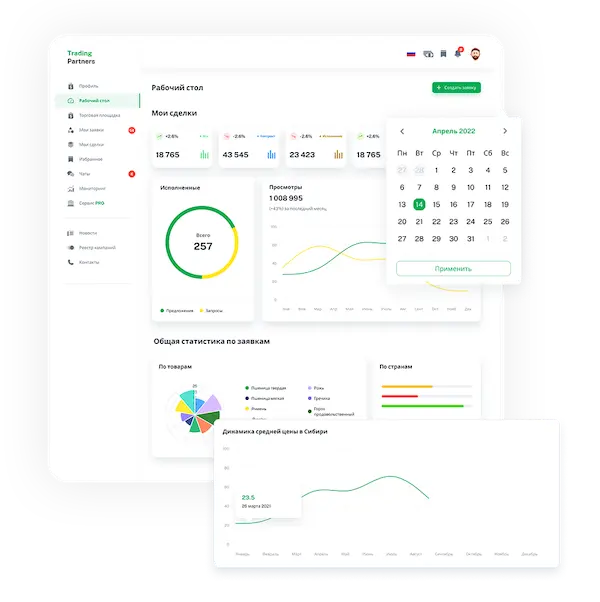What are the main stages of transporting apples from the tree to the store? What damages can the fruit sustain during this process?
First and foremost, it is necessary to determine the optimal time for harvesting. Overripe apples cannot be delivered in perfect condition. The fruit should be slightly underripe.
Each picker needs to learn how to correctly pick the fruits, applying the necessary force. Excessive pressure can lead to imperceptible damages that may result in rot.
This is especially important for delicate varieties such as "Golden Delicious," although there are varieties that are less susceptible to damage, such as "Aidared." However, we do not differentiate and harvest each apple with the same care.
Then, the apples are carefully placed in special boxes, holding from 200 to 260 kilograms. The most likely damages the fruits receive occur during transportation to the storage facility. Therefore, it is crucial to place the storage facility as close to the collection site as possible. We positioned the storage right in the center of the orchard to avoid damages.
What requirements are set for the roads within the orchard?
Each section of the orchard is accessed by a road laid with compacted sand that reduces vibration during the delivery of the harvest to the storage facility.
How is the responsibility for the safety of the apple divided between the producer and the retail network?
The sorted apples are accepted by a surveyor, a representative of the buyer, who checks the quality of the apples, their appearance, compliance with packaging, and pallets. They have the right to selectively choose and cut any apple from the batch. If the contract specifies the presence of red color on two-thirds of the apples, the surveyor may refuse to accept the shipment if the area of red color is less than stated. Apples are susceptible to diseases, with the most common being scab, and we have all seen black spots on fruits at least once. The surveyor understands that diseases cannot be completely avoided, and there is a standard - the number of spots on an apple should not exceed two. There is always a certain permissible variability in the shape of the fruit.
Then there are two options for dividing responsibility. On one hand, the surveyor accepts the goods and assumes the risk. On the other hand, the responsibility remains with the producer until the goods reach the distribution center of the retail network.
Are there risks associated with transportation through third-party transport companies?
Yes, and it is our task to control this. Before sealing the cargo, we install sensors in the vehicle that monitor compliance with temperature regimes and the speed of transportation. The carrier knows they are being monitored and tries to meet the requirements. However, the human factor is present everywhere; a driver may rush and make a sharp maneuver, damaging the packaging. In this case, we go to the site, restore the appearance of the cargo, and if it is not possible, we return the vehicle. But this happens very rarely and is considered extraordinary circumstances.
How has the demand for apples changed in recent years?
Apples are a very healthy product for the body, so there is always high demand for them.
How has the pricing policy changed in the conditions of increasing import substitution?
It completely depends on how much it costs to grow apples. There are many factors at play here. The first one is the human factor. To prune apple trees, you need to pay a worker. Today, a worker's salary is changing. Moreover, there is a shortage of labor. We hire a worker, pay them a salary, feed and house them; all of this has its cost. We constantly raise the salaries of permanent employees to maintain the workforce. To modernize production, we need loans that need to be repaid. Protecting trees from pests and diseases has become more expensive; the cost of protection has almost doubled. The cost of delivering apples has also increased. Earlier, we could deliver the cargo to the distribution center for forty thousand rubles, but this year the delivery cost is eighty or ninety thousand. All these expenses are reflected in the price for the consumer.
During the harvest, a large amount of apples appear on the market, and during this period, sales take place with minimal profitability. Last year, the minimum cost of apples was 47 rubles.
How much does an apple cost now, and what role does seasonality play in forming prices?
In early July, while the fresh harvest is not yet available, an apple costs 120 rubles. Every producer aims to preserve the harvest until April or June. When the mass release from storage begins, an excess of supply reduces the price. Therefore, it is necessary to be flexible. Sometimes it is more profitable to sell apples in December than in May. Analysis is done daily. The harvested crop, sales, and the amount of apples in storage are evaluated. Intuition comes into play, and a decision is made to sell apples in January or postpone sales to a later date.
Can prices for the upcoming season be forecasted?
This year, abnormal frosts have caused significant damage to the orchards in the Voronezh, Belgorod, Kursk, Lipetsk, and Tambov regions. There are producers who have lost almost 100% of their crop. All conditions point to a high price for apples this year.

 Trading platform
Trading platform 
 Monitoring
Monitoring  Express applications
Express applications 
 Fork Work
Fork Work 
 Service
Service  News
News  Directory
Directory 
